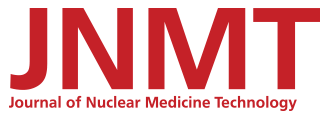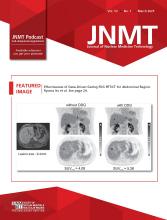Since first introduced by Griffith et al. in 1966 (1), gastric emptying scintigraphy (GES) of a radiolabeled meal has been considered the gold standard for measuring gastric emptying. With a properly radiolabeled ordinary meal, the volume of gastric emptying of solids or liquids is accurately measured without the need for geometric assumptions used by other imaging modalities.
The stomach is a complex organ. It is much more than a receptacle to store food before it enters the small bowel. This complexity includes multiple receptors in the wall of the stomach that are sensitive to physical and chemical stimuli as well as electromechanical and hormonal controls, all helping to sense and then respond to the gastric contents so that the ingested meal can be appropriately processed. As with any complex physiologic system, there are many ways the system response can be altered through changes in input and output stimuli. Therefore, the key to the reproducibility of GES, particularly the ability to compare results from one imaging center to another, is adherence to the technical requirements of the test, which include patient preparation (including but not limited to overnight fasting before testing, elimination of drugs that may affect gastric emptying, and patient glucose control), meal preparation, standardized image acquisition times and image processing, and final interpretation based on comparison to healthy control subjects.
In a 1995 review of gastrointestinal nuclear medicine, the following question was asked: “Can we prevent tarnishing a gold standard?” (2). Despite the recognition that GES was the most physiologic test for measuring gastric motor function, there was a need for more consistency in how GES was being performed and interpreted. This lack of consistency was underlined by the first Society of Nuclear Medicine and Molecular Imaging (SNMMI) procedure guideline for gastric emptying—published in 1999 (3)—which listed several meal options with the caveat that the results should be compared with normal values established for the meal in use. However, normal values for specific meals were hard to come by, and when they were provided, the normal values were often poorly documented with healthy control subjects. It was not until the publication of Tougas et al. in 2000 that critical, multiinstitutionally and internationally based normal values for the emptying of the liquid egg-white meal became available (4).
Although the publication of the Tougas meal with its associated normal values was immediately recognized as a major step forward for standardizing GES, there was limited progress in getting nuclear medicine imaging centers to change their practice patterns. Many continued to use their local favorite meal based on no or poorly established normal control values. Protocols for the frequency and timing of imaging and processing of the data were also inconsistent, and the reported results were often based on only 1–2 h of imaging.
Complaints from referring gastrointestinal physicians who could not compare results between imaging centers, and patient complaints that GES studies often were being repeated by different physicians with different meals and imaging protocols, generated a joint project of the SNMMI and the American Neurogastroenterology and Motility Society to develop an updated GES guideline in 2005. The joint committee of these 2 societies approved a final report, which resulted in 2 publications: “Consensus Recommendations for Gastric Emptying Scintigraphy: A Joint Report of the American Neurogastroenterology and Motility Society and the Society of Nuclear Medicine” (5) and the “Procedure Guideline for Adult Solid-Meal Gastric-Emptying Study 3.0” (6). In an editorial in The Journal of Nuclear Medicine in 2008, an urgent message was published that stressed the importance of these guidelines and appealed to the nuclear medicine community to “quickly adopt these new standards so we can achieve consistency and reliable results for our patients and referring physicians” (7).
In 2017, Farrell et al. (8) reviewed 127 labs for their compliance with the SNMMI GES procedure guideline 3.0. They used reports to the Intersocietal Accreditation Commission database to evaluate the GES protocols from all labs applying for accreditation from 2013 to 2015. They studied 14 key compliance variables, including medication withholding, medication withholding time, blood glucose measurement, blood glucose recording, fasting before testing, full versus partial meal ingestion, radiopharmaceutical dose, imaging protocol, calculation of geometric mean, proper decay correction, and reporting of percentage meal retention for all time points. They found that 69.3% of sites were not compliant with the content or preparation of the consensus meal and that only 3.1% of labs were fully compliant with all 14 variables. Over 50% of the labs were compliant with only 5 variables or fewer. Two of the most critical compliance variables—proper withholding of medications and checking of blood glucose—had the lowest levels of compliance. These authors pointed out that such low compliance was found 8 y after publication of the SNMMI GES 3.0 guideline while citing a report that it usually takes an average of 9.3 y for such practice guidelines to become customary (9).
Unfortunately, yet another recent report confirmed significant noncompliance with GES guidelines. In “Gastric Emptying Scans: Poor Adherence to National Guidelines” in 2021, Wise et al. used a questionnaire looking at key GES protocol requirements (10). In total, 121 of 872 medical institutions responded. Only 4 of 88 (4.5%) adhered to 3 critical measures: 4-h study duration, controlled blood glucose levels, and proper restriction of medications. Only 59% used the recommended meal, and 19% did not include in the report whether the patient had eaten the entire meal.
The group from the Intersocietal Accreditation Commission has done a recent follow-up (11) on whether there has been any improvement in compliance with the SNMMI guidelines since the Intersocietal Accreditation Commission’s earlier study. For sites that had applied for accreditation from 2018 to 2021, the Intersocietal Accreditation Commission again used its database to look at the same 14 variables used in its 2017 publication. From 118 labs applying, the study found that “compliance is improving in some key areas but remains suboptimal in others.” Overall, labs were compliant on average with 8 of 14 variables, but only 4 sites were compliant with all variables. An improvement was noted in the use of the consensus meal, now 62% versus 30% previously, and greater compliance found with measurement of retention percentages instead of half-emptying times (65% vs. 35% 5 y prior). The variable with lowest compliance was the recording of blood glucose (3%). As there is a well-known association between elevated blood glucose and slow gastric emptying, this is a critical value to check before performing a GES test (12–14). Many labs had earlier said that glucose testing was not a point-of-care test available in their departments; however, today blood glucose is routinely measured for all 18F-FDG PET studies and should therefore be routinely available for patients undergoing GES.
The recent publications cited above (8,10,11) show that there remains an inadequate response on the part of nuclear medicine departments to comply with the most basic guidelines and technical requirements for performing GES. It is clear that our understanding of the complexity and multifactorial components that contribute to overall gastric motility and ultimate gastric emptying of a meal has increased significantly since the publication of the current SNMMI 3.0 guideline. Recent advances have demonstrated that other measurements available from GES, such as fundal accommodation and analysis of antral contractions using dynamic antral contraction scintigraphy, have clinical value and may eventually be added to the current acquisition and processing of GES (15,16). The SNMMI committee on procedure standards has recently initiated an update to the GES practice guideline (Kevin Donohoe, oral communication, 2023). So, although this is an exciting time marked by our ability to provide more advanced scintigraphic information for detecting abnormal gastric motor function, the addition of more advanced imaging and processing will only increase the complexity of the test and therefore the need for adherence to standard study protocols. Only with adherence to standard protocols will we be able to speak the same language when managing these complex patients.
In the report from Wise et al. noted above, the authors state: “The significant impact of a gastroparesis diagnosis, or misdiagnosis, on both patients and the health care system mandates that GES be performed according to a validated protocol” (10). It is essential that there be greater compliance with current and future guidelines if we are to maintain GES as the go-to gold standard test for the diagnosis and management of patients with suspected gastroparesis.
DISCLOSURE
No potential conflict of interest relevant to this article was reported.
Footnotes
Published online Nov. 14, 2023.
REFERENCES
- Received for publication October 3, 2023.
- Accepted for publication October 4, 2023.







